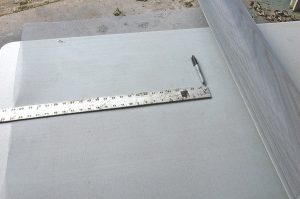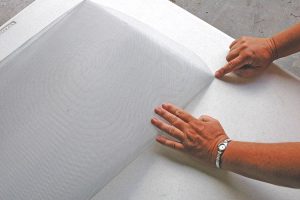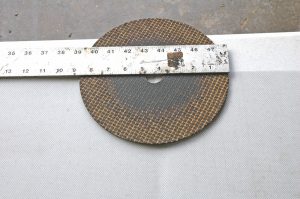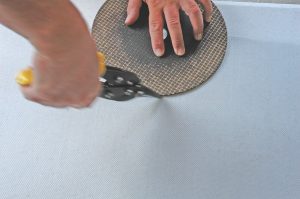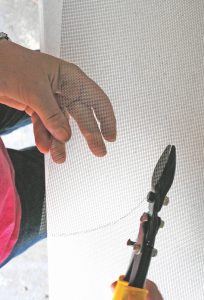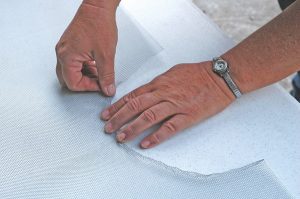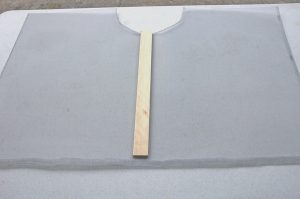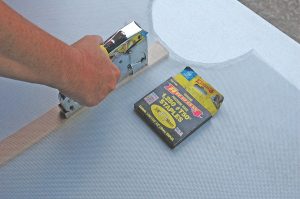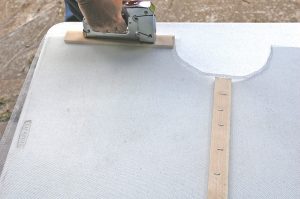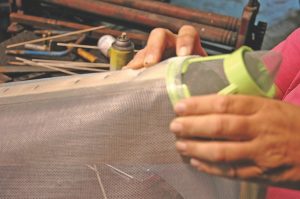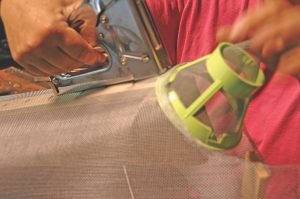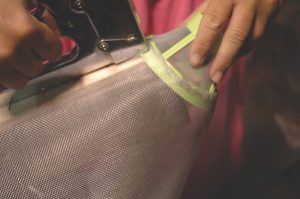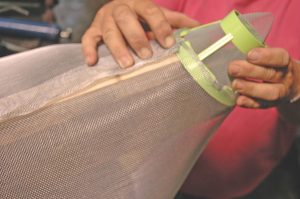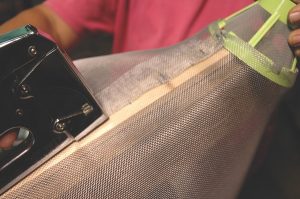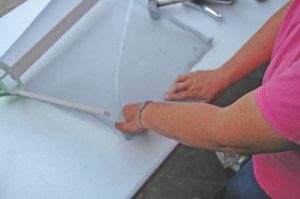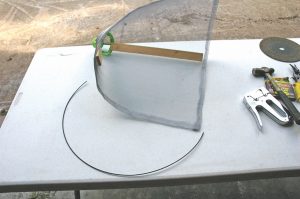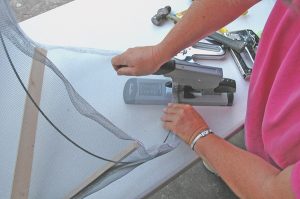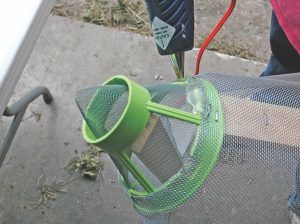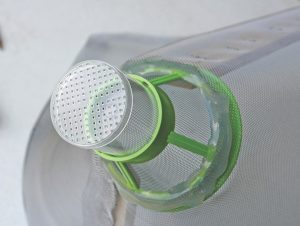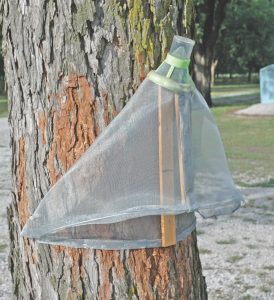Building Pecan Weevil Circle Traps

A weevil circle trap posted on a pecan tree. (Photo by William Reid)
To construct your own traps, assemble the materials and tools listed below, then follow the step-by-step instructions as pictured.
Tools
Metal shears
Heavy-duty staple gun
Heavy-duty book stapler
Glue gun
Ruler
Trap Materials
Aluminum screen wire, 36 inches wide
Wood strips 1 ½” wide, ½” thick
½ and 3/8 inch staples for HD staple gun
¼ staples for book stapler
10 gauge wire
Glue sticks
Boll weevil trap top assembly (available from Great Lakes IPM, 1-800-235-0285 or www.greatlakesipm.com)
Step 1. Measure out 24 inches of screen wire and cut with shears.
Step 2. Fold the screen wire in half (lengthwise). Press on the fold just enough to mark the center of the screen.
Step 3. Use a round object (8 ½” – 9” dia.) to help trace a semicircle at the marked halfway point of the wire.
Step 4. Use the tip of the shear to trace the semicircle on the wire.
Step 5. Use the shear to cut out the semicircle.
Step 6. Fold over the screen wire along the edge of the semicircle to form a smooth edge.
Step 7. Place a 17-inch piece of wood strip down the middle of the screen wire. Fold the screen wire along the bottom over twice so it makes a smooth, strong edge.
Step 8. Flip the screen wire over and staple the screen to the wood strip using 3/8-inch staples. The first staple should be placed 2 inches down from the bottom of the semicircle.
Step 9. Attach an 11-inch strip of wood along the upper edge of the screen, again staple starting 2 inches from the semicircle.
Step 10. Clamp a 30-inch piece of 2×4 into a bench vice at a slight upward angle from the horizontal. Place the long wood strip on top of the 2×4 and slip a boll weevil trap top under the screen wire.
Step 11. Staple the boll weevil trap top onto the wood strap using a ½-inch staple.
Step 12. Turn the trap over, wrapping the screen wire over the boll weevil trap top, and place the short wood strip on the 2×4. Pull the screen tight, setting the trap top on top of the wood strip but under the screen wire. Staple in place with a ½-inch staple.
Step 13. Wrap the other side of the screen around the trap top, then staple at the top with another ½-inch staple.
Step 14. Firmly attach the rest of the screen wire along the short wood strip using 3/8-inch staples.
Step 15. Fold the screen wire over about 1 ½ inches along the outer edge of the trap. As you make the fold, tuck the fold under the short wood strip.
Step 16. Cut a 36-inch piece of 10-gauge wire. Place the wire under the fold you just made around the outer edge of the trap.
Step17. Use the heavy-duty paper stapler to hold the wire in place under the fold.
Step 18. Crimp the screen wire tightly around the boll weevil trap top. Fill in any gaps between the screen wire and trap top with hot glue.
Step 19. Use a pencil to widen the hole in the top of the boll weevil trap top, then install the plastic cylinder and perforated top.
Step 20. Scrape the rough bark off the tree at the point of trap installation. Use deck screws to attach the long wood strip to the tree. Stretch out the screen wire across the bottom and staple to the tree using ½-inch staples.
Monitoring Traps
We like to install our traps by July 25. We check the traps at least 3 times per week and especially following a good soaking rain in August. When we capture an average of 2 weevils per trap, we fire up the sprayer and spray the grove. Depending on the year and soil moisture conditions, weevils can emerge continuously over 6 weeks or in a couple of short bursts following rain storms. By using the traps, we know exactly how weevils are behaving and how to time our insecticide applications.
The native trees at the Pecan Experiment Field have been sprayed for pecan weevil annually for more than 50 years. Needless to say, our resident weevil population has been driven down to near zero. However, we can still find weevil damage.
In our situation, weevils are not emerging in our grove but flying in from adjacent unsprayed native pecans or hickories. When adult weevils emerge under unsprayed trees but find no oviposition sites, females will migrate until they find a suitable nut cluster. Because we work so hard to ensure annual nut cropping, migrating weevils always seem to be able to find our native grove.
Trunk-mounted traps are not effective in detecting migrating weevils that are flying from tree canopy to tree canopy in search of nut clusters. To remedy this situation, we have begun to attach traps on wild trees outside our property line. Knowing what weevils are doing around our grove has proven just as important as monitoring within our orchard.

